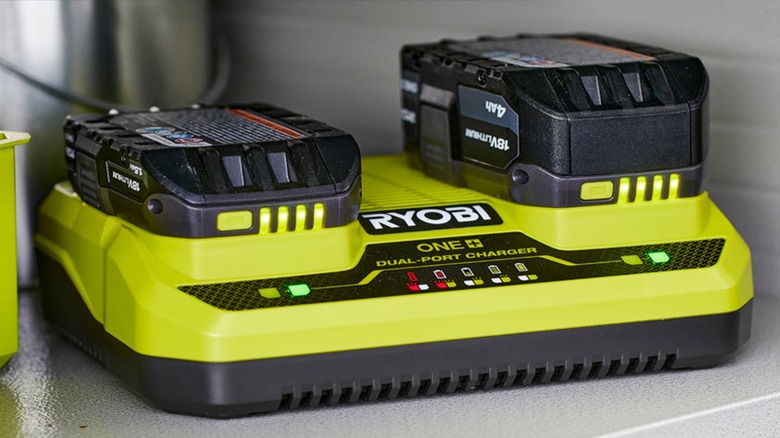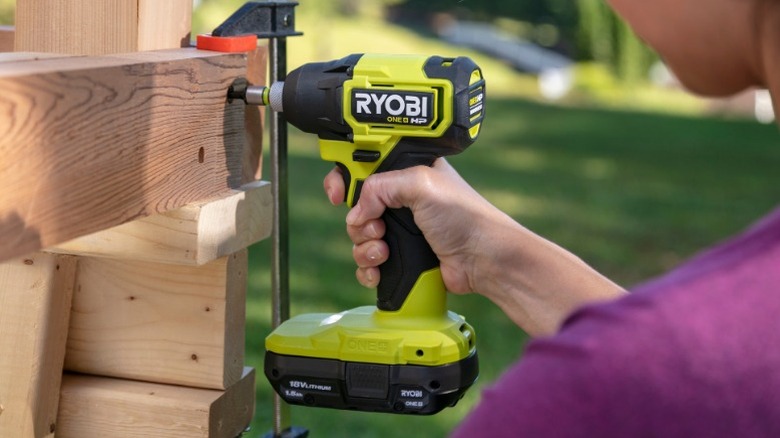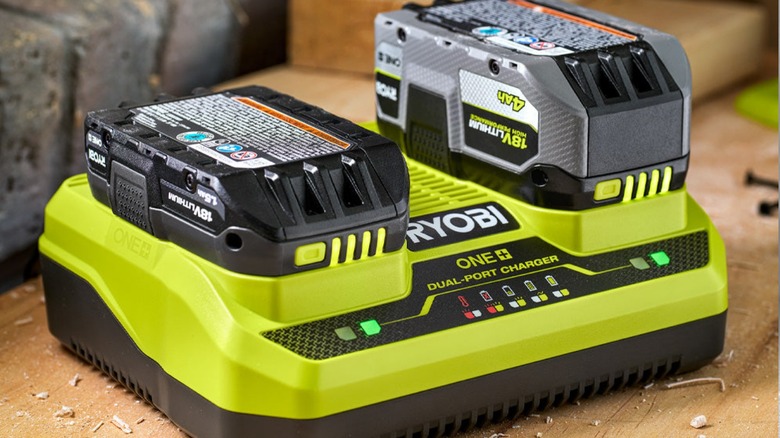Can You Mix And Match Ryobi Batteries Of The Same Voltage?
Ryobi is widely considered to be one of the best power tool manufacturers on the market, providing a wide range of products that are useful for everything from yard care and home maintenance to carpentry and automotive repair. One of the ways the company manages to keep these power tools affordable is through the interchangeable nature of its lithium-ion battery systems. This makes it easy to find the right Ryobi battery for your tool. Even so, compatibility might not be quite as straightforward as you think.
There are four voltage outputs currently offered by Ryobi: The USB Lithium system, which is a lightweight system used for low-voltage products, the midrange 18V One+ system, which powers most of the brand's handheld tools, the heavy-duty 40V system, which is for more power-hungry tools, and its 80V system. This last example is currently reserved for just one product: The company's 1000W Power Source. Each of these systems powers a wide range of tools and promises broad compatibility, so long as you pair tools from a certain system with Ryobi-brand batteries of the appropriate voltage. Even models with slightly different naming schemes, such as the Ryobi 40V and 40V HP batteries, can be used interchangeably. However, there are a few caveats that you might want to consider. Not all Ryobi batteries of the same voltage are part of the same system, lower capacities may limit the functionality of a tool, regardless of whether the battery is technically compatible, and the size and weight of the battery may play a role in the versatility of the tool.
Older Ryobi batteries might not be ideal for newer tools
All of the batteries that Ryobi sells in its current lineup are powered by lithium-ion cells. This wasn't always the case, however. The brand's older tools were powered by nickel-cadmium (NiCad) batteries. These were standard for the time, but there are several benefits to lithium-ion that make it a superior battery type. Lithium-ion can store more energy, weighs less, charges faster, has a low self-discharge, and doesn't have the same "memory effect" that was common in older batteries and would eventually affect their capacity.
Modern Ryobi batteries are compatible with all tools of the same voltage that Ryobi has ever made. They will even work in a few non-Ryobi products so long as they are designed to have the same fittings and operate on the same current. New Ryobi batteries will also work in older Ryobi tools that used to be powered by the NiCad batteries. The old NiCad batteries don't work on the newer chargers, but the opposite is true as well. Ryobi's newer One+ tools can technically draw power from the company's older batteries, but it's less than ideal. These newer tools were designed for the efficiency and power that come with the lithium-ion batteries. There are several reports from users who attempted to pair them and found that the old NiCad batteries drained incredibly quickly and that they ended up spending more time in the charger than in the tool. But more than that, they can be dangerous.
Thermal runway can cause batteries to explode
According to the instruction manual included with the newer One+ battery chargers, you should "Charge only Ryobi lithium-ion rechargeable battery packs. Other types of batteries may burst, causing personal injury or damage." This extends to third-party batteries as well as the company's own, older NiCad batteries. This is corroborated by the Techtonic Industries Safety Data Sheet for these batteries, which states that "There is a risk of fire if a charger is used with batteries other than those for which it is intended." It isn't just about chargers, though. Problems can occur even when using these batteries in the wrong tools. The Safety Data Sheet also states that "using other electrical tools or garden implements [than those intended by the manufacturer] can lead to injuries or fire." So why does this happen?
Ryobi doesn't outright state why these batteries might burst or catch fire, but the most likely suspect is thermal runaway. This is when a cell within the battery enters an uncontrollable, self-heating state. This phenomenon can occur in both lithium-ion and NiCad batteries. Overcharging is the most common culprit, but thermal runaway can also occur when overdischarging (using a battery with a tool below its recommended voltage range), when the battery is damaged, when it's exposed to high temperatures, or when used with otherwise incompatible devices.
In the event that a fire does occur, the TTI Safety Data Sheet also claims that you should "always use water spray to fight fires with lithium ion batteries" and not more specialized extinguishing substances. It states that, "the cooling effect of water hampers propagation of the fire to battery cells which have not yet reached the critical temperature for ignition ("thermal runaway")."
Capacity matters
Not all batteries of the same voltage system are the same. According to Acme Tools, "A battery's voltage tells you how much power the cell generates in ideal conditions. It signifies the maximum energy potential of a battery and serves as a necessity to produce an electric current." This means that the voltage is a measurement of the battery's potential for how much electricity can move through a circuit at a time. It does not refer to the total amount of energy that the battery can hold. The number and size of the cells inside the battery's casing dictate how much energy the battery can hold on a single charge. This is referred to as an amp-hour (Ah) rating. A higher Ah means that a battery has a higher capacity to store electricity.
Both Ryobi's 18V and 40V batteries are available in a wide variety of capacities. Both of them offer a small but affordable 2Ah battery on the low end and go all the way up to the more expensive, but higher-capacity 12Ah battery.
These different capacities should technically offer the same voltage so long as they are part of the same system, but it doesn't always work out that way in practice. Several Ryobi users have reported that voltage sag can occur when a tool that needs a lot of power is drawing from a low-amperage battery. This results in dips in power. Circular saws, for instance, require a large amount of power to operate, and a 2AH 18V One+ battery may struggle to keep up with the demands of the tool. This might be part of the reason why Ryobi pairs 4Ah batteries with the saws in the kits that it sells.
Consider the weight
You might think that this means that you should simply invest in large-capacity batteries for all of your tools, but there may be a few practical drawbacks to going that route as well. (Not to mention a significant amount of added expense.)
The larger-capacity batteries are physically bigger and heavier than the smaller ones. The Ryobi 18V 12Ah battery weighs 3 lbs, 6oz, and is 5.7 inches tall, 5.25 inches long, and 3.5 inches wide. This means that it will add a significant amount of size and weight to whatever tool you choose to pair it with. This probably won't be much of a problem in larger pieces of gardening equipment like a string trimmer, or other big two-handed tools like a reciprocating saw, but it can make smaller tools that require more dexterity difficult to operate. One-handed tools like drills, angle grinders, and sprayers might grow awkward and fatiguing to use with the added weight. You might also find that they're harder to maneuver in tight spaces.
Certain tools, like Ryobi's Power Scrubber, also come with a waterproof shield that might not be able to contain the larger batteries. So, you may need to consider whether the physical dimensions of the large-capacity batteries are compatible with the tool you want to use them with, even if there's nothing stopping the tool from being able to draw power from them.




